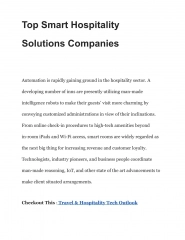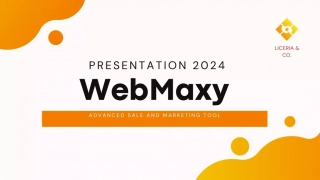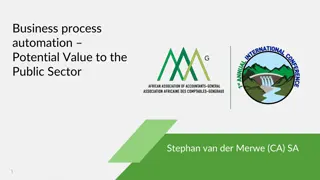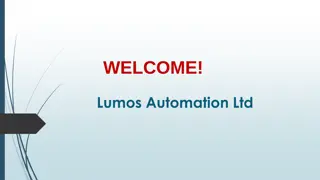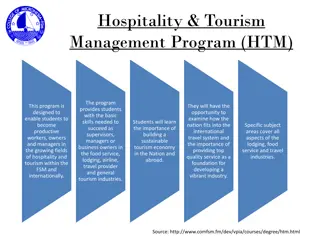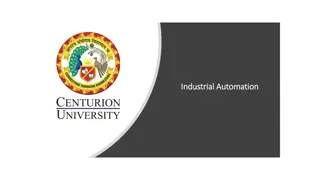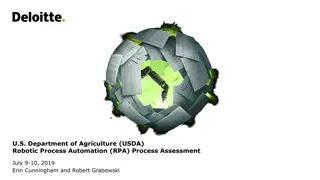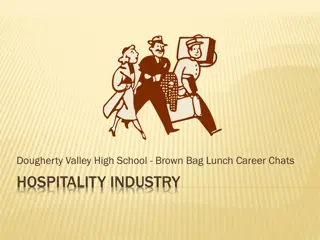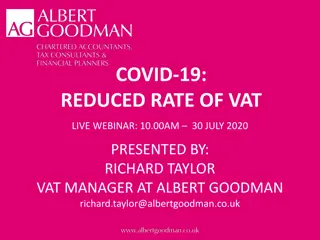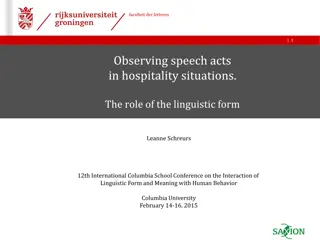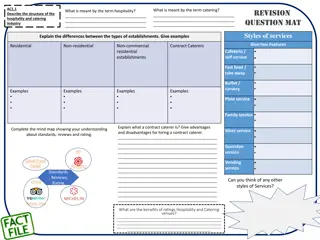
Automation in Hospitality Industry
Ms.S.Agalya, an Assistant Professor in Food Service Management and Dietetics, covers the topic of automation in the hospitality industry, focusing on Property Management System (PMS), Reservation Module, Microcomputers, and Telephone Call Accounting System (CAS).
Download Presentation

Please find below an Image/Link to download the presentation.
The content on the website is provided AS IS for your information and personal use only. It may not be sold, licensed, or shared on other websites without obtaining consent from the author. If you encounter any issues during the download, it is possible that the publisher has removed the file from their server.
You are allowed to download the files provided on this website for personal or commercial use, subject to the condition that they are used lawfully. All files are the property of their respective owners.
The content on the website is provided AS IS for your information and personal use only. It may not be sold, licensed, or shared on other websites without obtaining consent from the author.
E N D
Presentation Transcript
Name of the Faculty : Ms.S.Agalya Mobile Number : 8428141101 Designation : Asst Professor Department : Food Service Management and Dietetics Programme : M.Sc., Food Service Management and Dietetics Batch : 2016-2017 Onwards Semester : IV Course : Food Service Facilities Course Code : P16FS41 Unit : V Topic Covered : Automation in the Hospitality Industry
Automation in Hospitality Industry
PROPERTY MANAGEMENT SYSTEM (PMS) PMS, the term is generally used to describe a set of computer programs that directly relate to front office and back office activities Front office Applications consist of series of software programs or modules that include hotel reservation, room management and guest accounting functions. A variety of stand-alone applications may also be interfaced with PMS. Popular interfaces include microcomputers, point of sale systems, call accounting systems, electronic locking systems, energy management systems, auxiliary guest service devices and guest operated services. PMS packages contain modules covering accounting and internal control functions.
Reservation module Enables to quickly process room requests, generate timely and accurate room revenues, and forecast reports Reservation received at a central reservation location can be processed, confirmed and communicated to the appropriate branch of the hotel before the reservationist actually ends the call with the guest on the telephone. When the destination hotel uses PMS, the reservation module receives the data forecasts, which are immediately updated. In addition, the reservations data can be automatically reformatted into preregistration material and an updated expectedarrivals list could be directly generated from the central reservation system.
Micro computers Expanding capabilities Transferring data from the hotel systems to microcomputer enables the management to use data continued in the hotel s systems software with applications designed for the microcomputer Accounts can be maintained by - word processing, spreadsheets, management communication programs data processing electronic database and
Telephone call accounting System (CAS) Enables hotel to take control over both local long-disturbance services A call accounting system also place and charge outgoing calls. When CAS is interfaced with a front office guest accounting module telephone charges can be immediately posted to the appropriate folios
Electronic Locking System Many types of electronic locking system available today. These system often interfaced with a front office computer system. Thereby enabling management important control measures the to exercise
Energy Management System Interfacing energy management system with hotel computer system links energy controls of a room with the front office management package This system monitors room temperature with the help of computer This may lead to significant reduction consumption and lower energy costs in energy
Auxiliary Guest Service Devices Automation has made easy, many auxiliary guest services such as the placement of wakeup calls and the delivery of message to guests These functions are performed by devices electronic message waiting systems mailbox systems marketed as stand alone systems. and that voice are
Guest operated Devices Guest operated devices can be located in a public area of the hotel or in the rooms The devices located within a room are designed to be user- friendly systems Variations of such devices within the rooms can provide concierge lever services to the guests
POINT OF SALE SYSTEMS Any cash transaction between a customer and a food service personal at different sales point in a hotel or hospital Each and every service out let in hotel - a coffee shop, restaurant, laundry service , front office ,boutique etc are centrally connected with a net working system enabling the hotelier to post and update the guest account immediately for quick money transaction. Also ensures that all the facilities received by the customer is tagged and account immediately Touch screen display helps both the hoteliers and customers to speed up the order taking and billing process.
Benefits of Point of Sale Reduces the operating Cost Decreases Human error while taking orders and billing. Quicken the food service time and procedure in turn. Environment friendly as it reduces the paper work. Helps to record, track and foresee sales of all food products. Predicts the sales performance of a particular menu over a period of time. Aids in appraising the work culture and performance of a particular staff or a team. Tracks inventory usage and reserves. Facilitate usage of credit and debit cards. Channelizes proper communication between the kitchen and service staff in hotel and dietary departments. Time saving since it reduces the number of trips from kitchen to food and beverage service centers. Minimizes the risk of theft and misappropriation of inventories.

